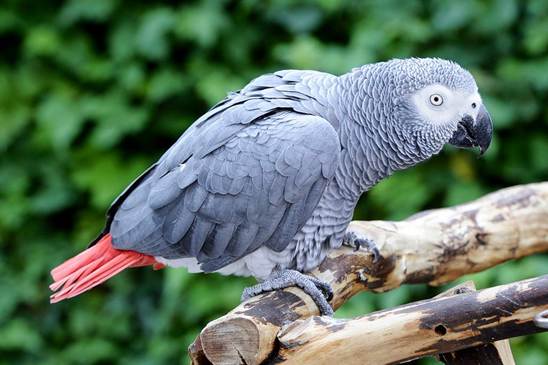Why is it in News?
- An RTI investigation by The Hindu found that no Indian State or Union Territory (except Kerala) has any registered breeder or authorised pet shop for the African grey parrot (Psittacus erithacus).
- Despite this, the species is easily available in Indian pet markets, pointing to massive illegal import, unregulated breeding, and black-market trade.
- Highlights a serious disconnect between CITES obligations, Breeder Licence Rules (2023), and India’s domestic enforcement.
Relevance
- GS3: Environment – wildlife trafficking, CITES Appendix I compliance, exotic species regulation.
- GS3: Biodiversity Conservation – endangered species protection, enforcement gaps.

What is the African Grey Parrot?
- Scientific name: Psittacus erithacus.
- Native range: Central and West African rainforests.
- Known globally for exceptional cognitive abilities, advanced mimicry, and emotional intelligence; among the most trafficked parrots in the world.
Conservation Status
- CITES Appendix I
- International commercial trade is banned.
- Any movement requires CITES permits, import approvals, and individual registration.
- IUCN Status: Endangered
- Populations decimated by wild capture, habitat loss, and illegal pet trade.
- Decline estimated at 99% in some regions of DR Congo and Cameroon.
Why is the African Grey Parrot Easily Available in India Despite Being Appendix I?
- India has no licensed breeders, meaning legal domestic trade is almost impossible.
- Yet, the species is widely sold in:
- Kerala and Tamil Nadu markets
- Bengaluru, Hyderabad, Mumbai, Kolkata pet circuits
- Indicates illegal imports, underground breeding, and unregulated pet shops.
Key RTI Findings
- RTIs were filed with 19 States/UTs.
- Only Kerala reported receiving 17 applications for breeder licences (not approvals).
- Many States responded with:
- “No data available”
- “Species not found in our divisions”
- “No registered traders/breeders”
- Shows absence of:
- Monitoring systems
- Registries
- Compliance with CITES requirements
Regulatory Framework: What the Law Requires (But Isn’t Followed)
A. Breeders of Species Licence Rules, 2023
To legally breed African grey parrots, applicants must have:
- CITES import permit
- DGFT import licence
- No Objection Certificate from State Chief Wildlife Warden
- Proper enclosures, veterinary records, mortality logs
- Individual registration of each bird
Reality:
- Almost no breeder meets these thresholds.
- Most parrots sold in India never had a CITES entry.
B. Mandatory State Registry
- States must maintain records of all exotic species.
- This requirement is rarely followed; most departments said they do not maintain such registries.
Why States Fail to Regulate the African Grey Parrot ?
- Lack of trained staff to identify exotic species.
- No routine inspections of pet shops, breeders, or households.
- High demand makes enforcement politically unpalatable.
- Disaggregated authority: Forest Dept, Customs, DGFT, AWBI – no integrated system.
- Pet shops operate in unregulated commercial spaces (apartment basements, scrap shops).
- Illegal breeders operate in hidden networks.
The African Grey Parrot: Why It Is a Priority Conservation Concern
A. Global Trafficking History
- Among the top three most smuggled parrots globally.
- Over 1.5–2 million individuals removed from the wild since 1975.
B. Biological Vulnerabilities
- Slow breeder: 1–2 chicks per year.
- Requires complex social structures; captivity stresses them.
- Wild capture leads to:
- Mortality rates >60% during transport
- Genetic depletion
- Collapse of local populations
C. Ecological Importance
- Seed disperser for African forests; ecological role significant.
India’s Role in the Illegal Trade Chain
- India is emerging as a major demand hub for exotic pets.
- Entry routes:
- Myanmar–Mizoram corridor
- Bangladesh smuggling networks
- Dubai/Thailand commercial flights
- Lack of centralised tracking encourages:
- Fake certificates
- Mis-declaration as captive-bred birds
- Use of private courier networks
Biosecurity & Zoonotic Concerns
Experts warn that exotic species trade carries major risks:
- Zoonotic diseases like psittacosis, avian influenza, paramyxovirus.
- Possibility of becoming invasive species if released.
- No quarantine system for most exotic birds entering India.
Why Enforcement Gaps Persist ?
- Pet trade is fragmented and informal.
- Forest Departments are not equipped for household-level enforcement.
- Huge discrepancy between law and ground reality.
- Social acceptance of exotic pets reduces reporting.
- Black-market networks are deep, decentralised, and profitable.
Viewpoints from Key Experts
- Wildlife Justice Commission: States must maintain complete registries of exotic species; this is largely not happening.
- Wildlife Trust of India: Kerala, Tamil Nadu, Karnataka are hubs for exotic trade; state authorities cannot “go house to house”, so compliance must be system-driven.
- Researchers: Current breeder licensing requires high documentation; most pet shops circumvent it.
Core Reasons for the African Grey Parrot Crisis in India
- High demand + low awareness
- Loopholes in import monitoring
- Poor inter-agency coordination
- Lack of breeder registration
- Absence of a nationwide exotic species database
- Weak inspection and enforcement systems
- Cheap supply from African trafficking routes
Way Forward
A. Regulatory Strengthening
- Create a National Exotic Species Registry linked to:
- Customs
- DGFT
- CITES database
- Mandatory microchipping and unique ID for every parrot.
- Integrate Forest Dept + Customs + Quarantine stations.
B. Market Reform
- Formal licensing of pet shops under strict norms.
- Ban sale of CITES Appendix I species in open markets.
- Regular audits of breeding facilities.
C. Biosecurity
- Mandatory quarantine for all imported exotic birds.
- Veterinary certification tracking.
D. Social Measures
- Public awareness on:
- Legal consequences
- Biohazards
- Conservation impact
- Encourage adoption of Indian species within WPA norms.



